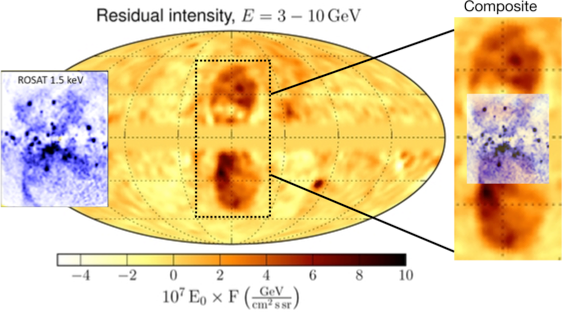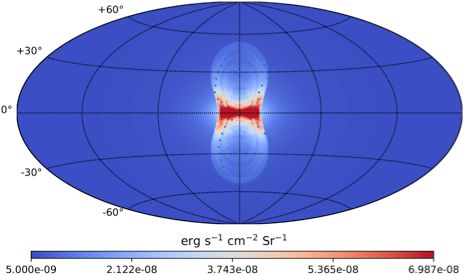
A pair of gigantic gamma-ray bubbles centered on the core of the Milky Way galaxy were discovered by the Fermi Gamma-ray Space Telescope 10 years ago. But how these so-called “Fermi bubbles” arose was a mystery.
Recently, however, researchers at the Shanghai Astronomical Observatory (SHAO) of the Chinese Academy of Sciences have presented a new model that for the first time simultaneously explains the origins of both the Fermi bubbles and the Galactic center biconical X-ray structure, which was discovered in 2003.
According to this model, the two structures are essentially the same phenomenon and was caused by the forward shock driven by a pair of jets emanating from Sagittarius A* (Sgr A*) – the supermassive black hole lurking at the Galactic center – about five million years ago. The study was published in The Astrophysical Journal.
Fermi bubbles are two colossal blobs filled with very hot gas, cosmic rays and magnetic fields. Although they cannot be seen with the naked eye, they are very bright in diffuse gamma-ray emissions. In gamma rays, the Fermi bubbles have very sharp edges and the edges coincide well with an X-ray structure called the Galactic center biconical X-ray structure.
Seeing the very similar edges of Fermi bubbles and the Galactic center biconical X-ray structure, the SHAO researchers realized these structures might share the same origin. Furthermore, the biconical X-ray structure could be naturally explained by the shock-compressed thin shell of hot thermal gas driven by a past energy outburst from the Galactic center.
In previous theoretical models and computer simulations of the Fermi bubbles, two major competing energy sources were proposed, i.e., star formation at the Galactic center and Sgr A*. However, in both models, the Fermi bubbles are explained as ejecta bubbles, while the forward shock is always located much further away from the edge of the Fermi bubbles. In other words, these models could not explain the Fermi bubbles and the Galactic center biconical X-ray structure simultaneously.
In contrast, the theoretical model in this study, proposed by GUO Fulai and his graduate student ZHANG Ruiyu from SHAO, used computer simulations to demonstrate for the first time that the Fermi bubbles and the Galactic center biconical X-ray structure are the same phenomenon.
In this model, the edge of the Fermi bubbles is the forward shock driven by a pair of jets emanating from Sgr A* about five million years ago. “One good thing about this model is that the energy and age of the Fermi bubbles can be constrained by the X-ray observations quite well,” said corresponding author GUO Fulai. The age of the bubbles inferred in this study is also consistent with that derived from recent ultraviolet observations of some high velocity clouds along many sightlines towards the bubble region.
The new model indicates that the total energy injected during the Fermi bubble event by the supermassive black hole is close to that released by about 20,000 supernovae. The total matter consumed by Sgr A* during this event is about 100 solar masses.
"Another very interesting thing that we found in our study is that if the bubbles and the biconical X-ray structure share the same origin, they are very unlikely to be produced by star formation or black hole winds,” said GUO. Near the Galactic center, the biconical X-ray structure has a very narrow base, while the forward shock produced by star formation or black hole winds can easily propagate to large distances, leading to a base much wider than observed.
In contrast, collimated jets deposit most of the energy quickly to large distances along the jet direction, naturally leading to a narrow base for the shock front near the Galactic plane. The supermassive black hole in our own Galaxy has been very quiescent in recent years without any evidence of current jet activities, but “our study strongly suggests that a pair of powerful jets emanated from it about five million years ago, lasted for about one million years, and produced the gigantic Fermi bubbles still seen today,” added GUO.

Fig.1: Fermi gamma-ray and ROSAT X-ray observations of the Galactic center, clearly showing that the Fermi bubbles coincide with the Galactic center biconical X-ray structure very well at low latitudes. (Credit: Bland-Hawthorn, J. et al.)

Fig. 2: Predicted X-ray 1.5 keV surface brightness map in the new model of ZHANG & GUO (2020). The dotted line delimits the observed Fermi bubbles in gamma rays. (Credit: ZHANG & GUO)

86-10-68597521 (day)
86-10-68597289 (night)

52 Sanlihe Rd., Xicheng District,
Beijing, China (100864)

